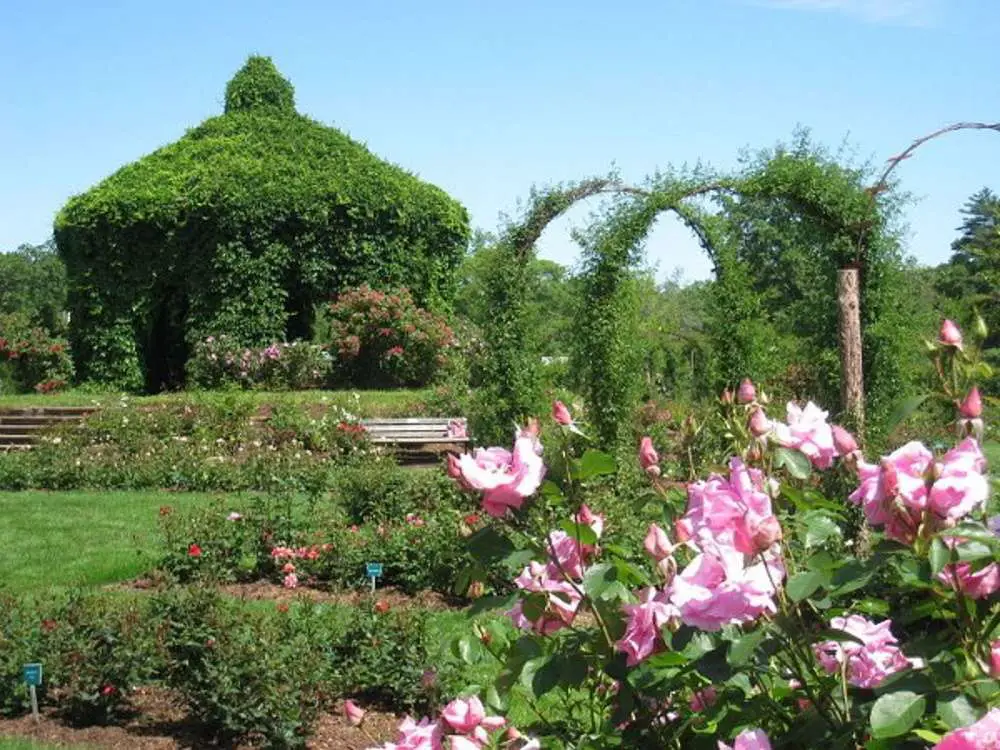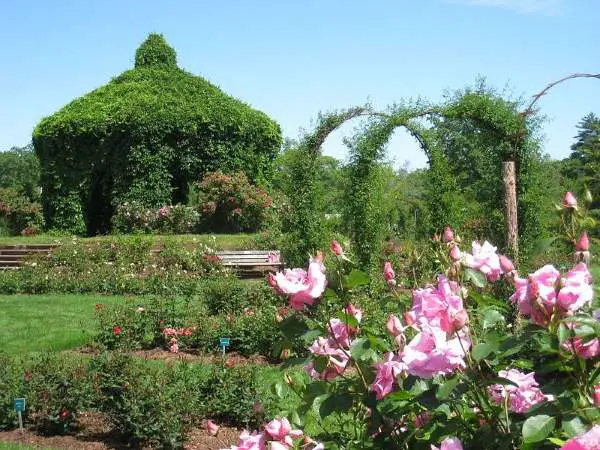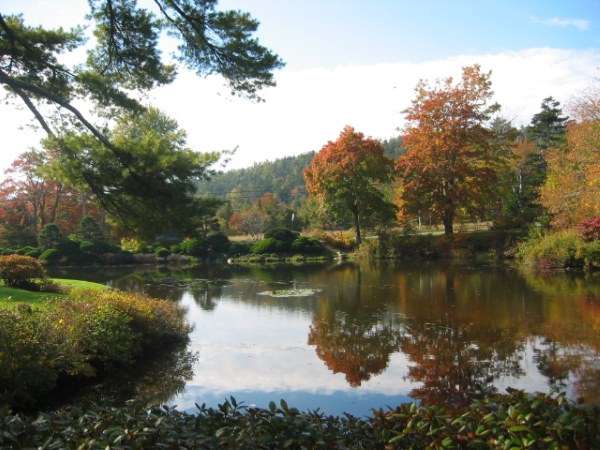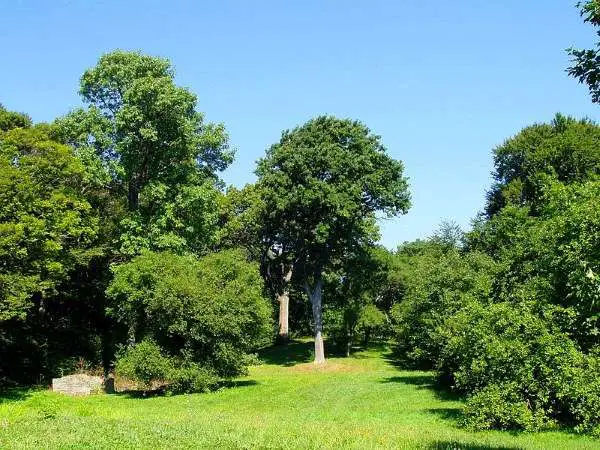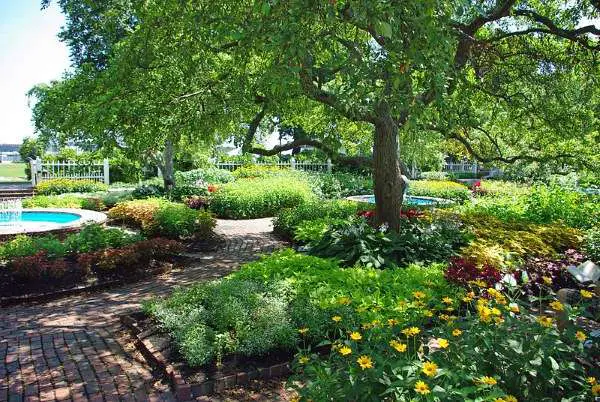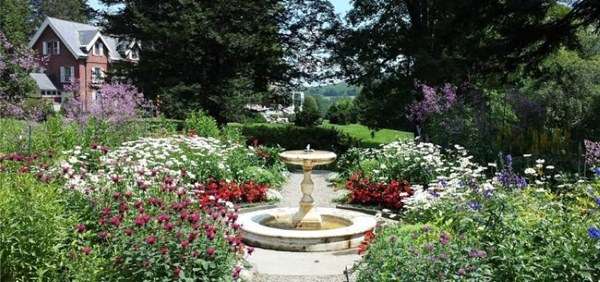Historic gardens have a special appeal to New Englanders if only because of our harsh winters and long dreary springs.
Though they offer the visitor serenity and relaxation, preserving historic gardens usually involves a great deal of hard work and commitment. Stewardship of historic gardens also requires knowledge of horticulture, garden design, landscape design, history and often architecture and architectural history.
Here, then, are six historic gardens, one in each New England state.
Elizabeth Park
Elizabeth Park in Hartford is the oldest municipal rose garden in the United States with 800 rose varieties.
Charles M. Pond, who financed the New York, New Haven & Hartford Railroad, bequeathed his estate to Hartford — but only if the city named it after his late wife. In 1897, Hartford took possession of the 102-acre site.
Park superintendent Theodore Wirth created the 2.5-acre Rose Garden in 1904. The city decided it couldn’t afford the historic garden in the 1970s, so a group of volunteers rescued it.
Today, the park includes the historic gardens, pathways, century-old Lord and Burnham greenhouses, lawns, tennis courts, bowling greens, a picnic grove and a pond. Ironically, the border between Hartford and West Hartford moved, so Hartford’s largest park now sits mostly in the neighboring town.
1561 Asylum Avenue, West Hartford, Conn.
Asticou Azalea Garden
Think of a Japanese stroll garden in coastal Maine and you’ve pretty much imagined the Asticou Azalea Garden. Though it started in 1957, the garden has a much longer history. It began as Reef Point, a Bar Harbor estate owned by Mary Cadwalder Rawle and Frederic Rhinelander Jones, Edith Wharton’s brother. Mr. and Mrs. Jones were also parents of landscape architect Beatrix Farrand.
Farrand inherited the property in 1935, and she and her husband Max decided to turn Reef Point into a horticultural study center. The venture was less successful than the Farrands hoped, and Bar Harbor refused to grant them a tax exemption after the Maine fires of 1947.
Farrand then broke up her gardens, selling many of her plants to Charles Savage. He moved most of them to Thuya Garden, an English flower garden, but he thought the azaleas would do better next to a pond in Northeast Harbor. And so he created the Asticou Azalea Garden, which features cherry trees that bloom in spring, azaleas and rhododendrons in June, Iris in July, water lilies in August and fall colors in September and October.
Savage designed the historic gardens to inspire feelings of serenity, something you’ll need if you visit nearby Acadia National Park in the summer.
3 Sound Drive, Northeast Harbor, Maine
Arnold Arboretum
The Arnold Arboretum certainly counts as historic, as it started in 1872 because of a bequest from a whaling captain named James Arnold. But is an arboretum a garden? Well, yes. The Arnold Arboretum includes an herbarium, the wildflower-filled Cosmopolitan Meadow and the Explorers Garden, with plants from the North America-China Plant Exploration Consortium of the early 1900s.
The arboretum began when Arnold bequeathed part of his estate to Harvard, which added it to another country estate given to the college by Benjamin Bussey. In 1872, Harvard named botany professor Charles Sprague Sargent as arboretum director. Sargent worked with Frederick Law Olmsted to design the roads, pathways and gardens.
Harvard gave the Boston the arboretum in 1882, when it joined the city’s Emerald Necklace park system. The college got a 1,000-year lease and the responsibility for running the historic garden, now 281 acres.
The arboretum includes about 15,000 plants, including tiny trees in the Larz Anderson Collection of Japanese Dwarfed Trees, originally imported by Larz Anderson in 1913.
125 Arborway, Boston, Mass.
Prescott Park
Prescott Park provides a waterfront oasis for pedestrians strolling through the historic city of Portsmouth, N.H. Two sisters, Mary and Josie Prescott, inherited a fortune from their brother Charles in 1932. They decided to use the money to replace a seedy, industrial section of town with a public park.
The sisters began to systematically buy up land along the Piscataqua River, deeding the land to Portsmouth in 1940. They also set up a trust to maintain the 10-acre park in 1949.
Today, the University of New Hampshire donates plant material for the park’s flower beds, but the city maintains them. The park, popular among artists and wedding planners, features lawns, gardens, brick walkways, boardwalk piers, public docks, and an island for picknicking. The park stays open year-round, and in summer hosts outdoor Broadway musicals.
1 Water Street, Portsmouth, N.H.
Green Animals
The Green Animals topiary garden in Portsmouth, R.I., dates to 1859, when the Victorian mansion was built on a 7-acre estate overlooking Narragansett Bay.
Thomas E. Brayton, treasurer of the Union Cotton Manufacturing Company in Fall River, Mass., bought the property in 1872. He hired Joseph Carreiro as superintendent of the property in 1905, and Carreiro began to train topiaries. Carreiro also planted and maintained fruit trees, perennial beds, herb and vegetable gardens.
Later joined by his son-in-law, Carreiro created more than 80 topiaries, including a horse and rider, a unicorn, a giraffe, an ostrich, an elephant and two bears.
In the 1940s, the estate hosted a coming-out party for Jacqueline Bouvier and later a reception for First Lady Mamie Eisenhower. In 1972, Brayton’s daughter Alice left the estate to The Preservation Society of Newport County upon her death.
Today, Green Animals is the oldest and most northern topiary garden in the United States. It opens seasonally and includes formal flowerbeds, geometric pathways, rose and grape arbors and fruit trees in addition to the topiaries.
380 Cory’s Lane, Portsmouth, R.I.
Marsh-Billings-Rockefeller
The Marsh-Billings-Rockefeller National Historic Park was the boyhood home of George Perkins Marsh, a founder of both the environmental movement and the Smithsonian Institute. Frederick Billings, the president of the Northern Pacific Railroad, bought the property. He managed it according to the principles of land conservation put forth by George Perkins Marsh.
Mary and Laurance Rockefeller later bought the property in 1954. A series of prominent landscape architects, including Ellen Shipman and Robert Morris Copeland, created and altered the extensive gardens. Today they include an azalea and rhododendron garden, rock garden, cutting garden, a hemlock hedgerow and a stand of Norway spruce,
The property became a national historic park in 1992, its purpose to interpret the history and evolution of conservation stewardship in America. It is open from Memorial Day through October.
54 Elm St, Woodstock, Vt.
Images: Arnold Arboretum By Daderot at the English language Wikipedia, CC BY-SA 3.0, https://commons.wikimedia.org/w/index.php?curid=18516058; Asticou Azalea Gardens By Dudesleeper – Own work, CC BY-SA 3.0, https://commons.wikimedia.org/w/index.php?curid=17126170; Prescott Park By Bostonian13 – Own work, CC BY-SA 3.0, https://commons.wikimedia.org/w/index.php?curid=27655804; Green Animals By Brian Feathers, CC BY-SA 3.0, https://commons.wikimedia.org/w/index.php?curid=58062721. This story was updated in 2023.
